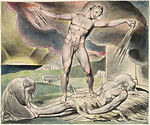Prince of Darkness (Manichaeism)
 |
In
ex nihilo, but only by copulation.[1]
Polytheism and dualism
Catholics erroneously assume that the Prince of Darkness had a divine essence, while in fact, the Prince of Darkness does not share any attributes with the Divine, thus Manichaeism would not worship multiple gods, but rather one true god.[2]
They are both two different principles: although eternally existing, clearly distinct. Only the light particles within humans are consubstantial to the Divine.
Alternative names
Manichaean missionaries adjusted the name of the Prince of Darkness depending on the audience. Towards Christians, they commonly used the name Satanas.[3] In relation to Islam, the expression Iblīs al-Qadīm (The Ancient Iblis) can be found,[3] but is also referred to as al-Šayṭān.[4] In Iranian Manichaeism, he was called Ahriman.[5] In Old Turkish, he is called šmnw.[6]
See also
- Angra Mainyu
- Devil
- Lucifer
- Mephistopheles
- Ptahil
- Prince of Darkness (Satan)
- Samūm
- Yaldabaoth
References
- ^ ISBN 978-0-834-82414-0pages 575–577
- ISBN 9789004255067p. 210
- ^ ISBN 9789004069060
- ^ http://www.iranicaonline.org/articles/asrestar-in-middle-persian-manichean-texts-a-kind-of-demons-often-associated-with-the-mazans second paragraph
- ^ Yuri Stoyanov The Other God: Dualist Religions from Antiquity to the Cathar Heresy Yale University Press 2000 9780300082531 p. 108
- ^ Werner Sundermann, “MANICHEISM iii. THE MANICHEAN PANDAEMONIUM,” Encyclopædia Iranica, online edition, 2018, available at http://www.iranicaonline.org/articles/manicheism-pandaemonium (accessed on 12 April 2018).


